Affiliate disclosure: This post may contain affiliate links. Please see our Privacy Policy.
Canning whole tomatoes is one of the simplest tomato canning recipes. The tomatoes are quickly blanched and peeled, packing into jars and water bath canning. Pressure can tomatoes if you’d like, but it’s not necessary with this easy water bath canning recipe for whole tomatoes.
I’ll walk you through all the options, both water bath canning and pressure canning, as well as packing whole tomatoes in water, tomato juice or just raw pack without added liquid.
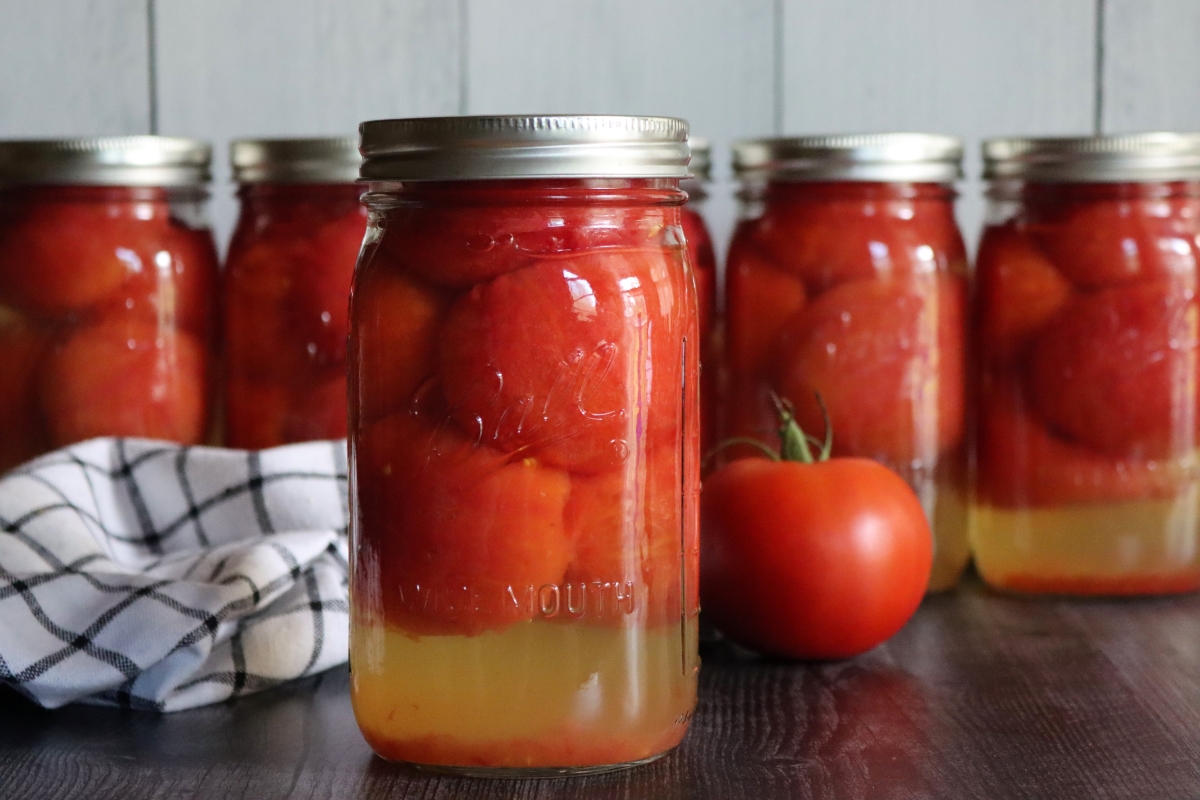
Table of Contents
- Preparing Tomatoes for Canning
- Acidification Before Canning Tomatoes
- Headspace for Canning Tomatoes
- Process Times for Canning Tomatoes
- Canning Tomatoes in Water (Raw or Hot Pack)
- Canning Tomatoes in Tomato Juice (Raw or Hot Pack)
- Canning Tomatoes Raw Pack without Added Liquid
- Tomato Canning Recipes
- Canning Tomatoes (Whole or Half) Recipe
- Summer Canning Recipes
- Water Bath Canning Recipes
There are literally dozens of safe canning recipes for tomatoes, but none have the versatility (and simplicity) of canning whole peeled tomatoes. This simple method for canning tomatoes allows you to preserve tomatoes in a shelf-stable way, without really limiting your options when it comes to cooking.
When you open the jar, they can turn into salsa, tomato sauce, minced into bruschetta, or simply be diced and added to your favorite curry. Just about anywhere you’d use a tomato, you can pop open a can of these and go to work.
It also saves time during the initial canning process, as the only step is peeling the tomatoes. Even that is technically optional, but it does dramatically improved the quality of home-canned tomatoes since the peels will slip off during the canning process anyway (and they get tough and bitter).
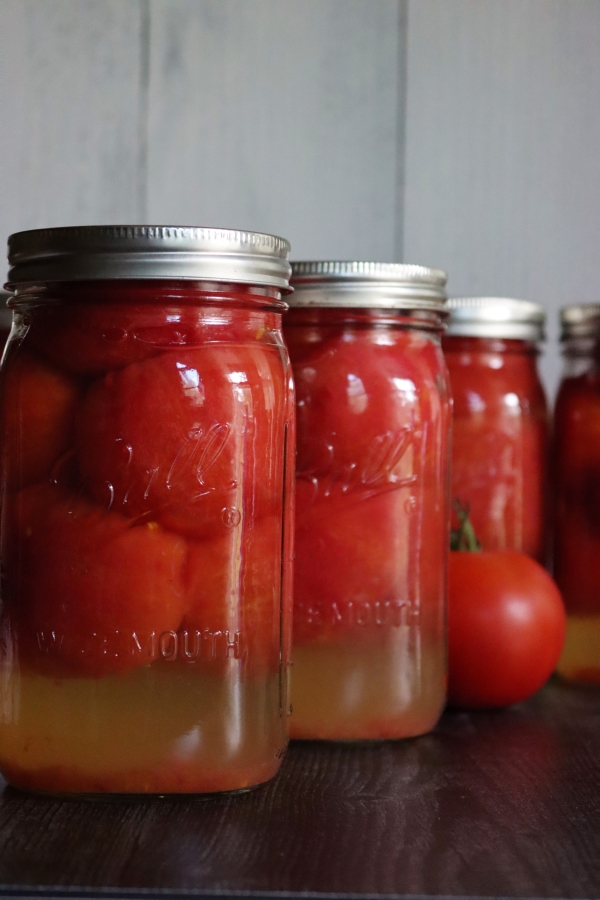
Even if you’re a novice canner, canning tomatoes really doesn’t require much in the way of equipment. You’ll need canning jars of course, and a large stock pot (or canning pot) for processing the jars in a water bath canner.
(If you’re not familiar with water bath canning, I’d suggest reading this beginners guide to water bath canning before you get started.)
When I first started canning tomatoes, I’d use just a single stockpot. First, bring it to a simmer before dipping the tomatoes into the water to peel. I’d get those all prepped and cooling in an ice bath, then use that same pot for canning the jars of whole tomatoes.
These days, since tomatoes ripen in peak summer heat, I’ve setup an outdoor canning kitchen right in my blueberry patch. I use a 3 burner high output stove, with a high capacity Amish Canner over two of the burners and a small side pot for blanching/peeling the tomatoes.
It’s a really efficient process, and the large canner allows me to process 15 one-quart jars at a time (or 36 one-pint jars, stacked double-decker with a divider). Given that the processing time for canning tomatoes (whole or half) is 40 minutes for pints and 45 minutes for quarts, large batch sizes really save me a lot of time, effort, and fuel.
The best part is, it doesn’t heat up the house at all, and I get to spend more time in the garden on a beautiful summer day. (Don’t worry, indoors or out, the process is still the same.)
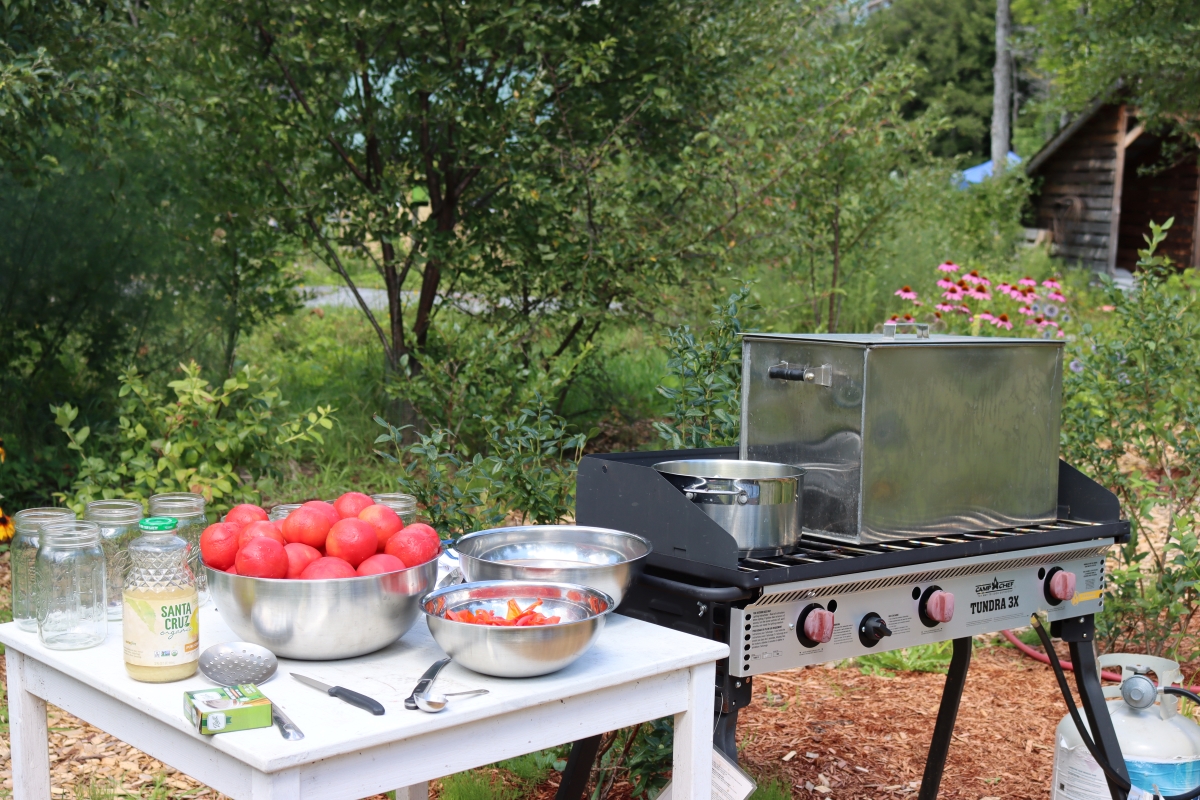
Preparing Tomatoes for Canning
The first step in canning tomatoes is peeling them.
This is technically optional, and you can opt to just raw pack the whole tomatoes right into a jar…but the quality is really going to suffer.
When tomatoes are exposed to boiling temperatures, the skin will crack and peel off and you’ll have floating hunks of tomato peel inside your canning jars. That, in theory, isn’t that big of a problem, cosmetic mostly and they can be fished out when you open the jars to use the tomatoes.
The real problem is that tomato peels will can make home-canned tomatoes taste bitter, and it’s really best to keep them out of the jars all together.
Some canners opt to freeze the tomatoes whole, which causes their skin to crack and the whole frozen tomato can be skinned gently with your fingers while running it under warm water in the sink. There’s a tutorial on that method here.
That, unfortunately, requires that you have ample freezer space to freeze the tomatoes in the first place, and my home freezers are rapidly filling up with other garden produce at this time of year.
(If you do have the freezer space, this method allows you to spend time canning tomatoes in the off-season, delaying it until the weather turns cooler, so it’s not a bad option in that case.)
Still, I choose the quick way, which is dipping tomatoes into boiling water for about 60 to 90 seconds, just until their skins crack.
The total time will depend on the size and variety of tomato, as some types crack in as little as 30 seconds and others are more stubborn. If you watch the pot you can see it happen and pull each one out with a slotted spoon right as the skin breaks.
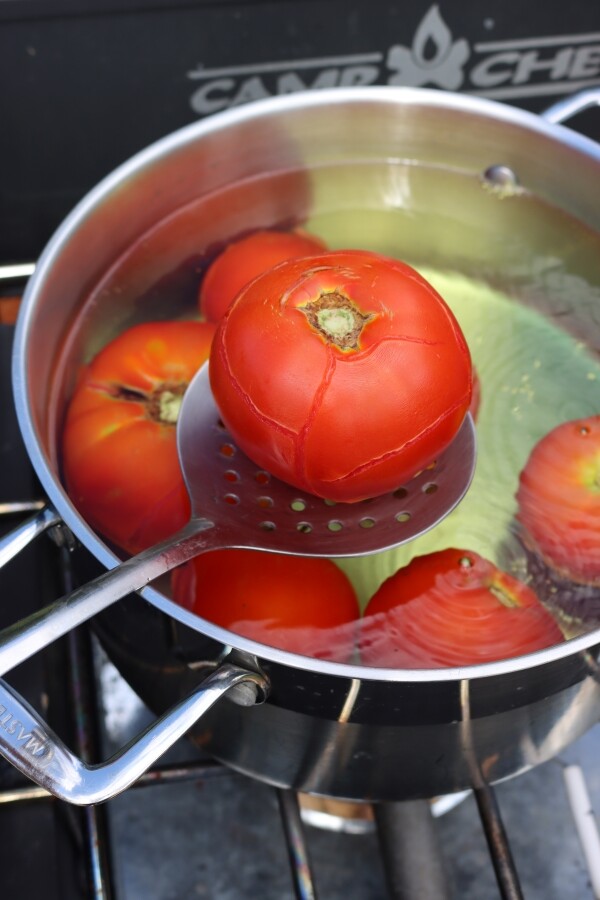
This quick blanching not only cracks the skin, but it flash cooks a thin layer of tomato flesh right under the skin. This will allow you to cleanly slip the skins from the whole tomatoes.
The problem is, they’re boiling hot at this point, and you need to flash cool them so that they don’t continue to cook.
Take the cracked tomatoes right from the boiling water and drop them in a bowl (or bucket) of cool water. Ice water is nice, but cool well water works just as well (mine comes out the tap at around 45 degrees F anyway, so I skip the ice).
Either way, keep checking on that water to ensure it’s still cool, and replace it as it heats up if you’re canning a large batch of tomatoes.
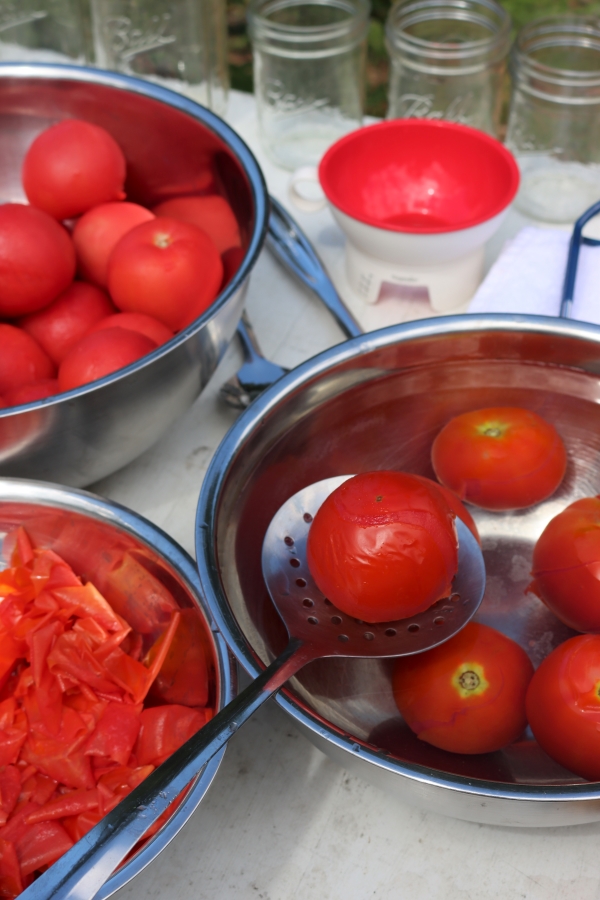
Once the tomatoes have cooled enough to touch, the next step is slipping the skins. This should be pretty effortless, and the skins should slide off the tomato with very light finger pressure.
It should only take a few minutes to peel 20 to 30 pounds of tomatoes, leaving you with a bowl of beautiful tomatoes ready for canning and a second bowl of tomato peels.
(If they’re not coming off easily, pop them back into the boiling water again for another 30-60 seconds. This is rarely necessary though, and for the most part, they slip easily.)
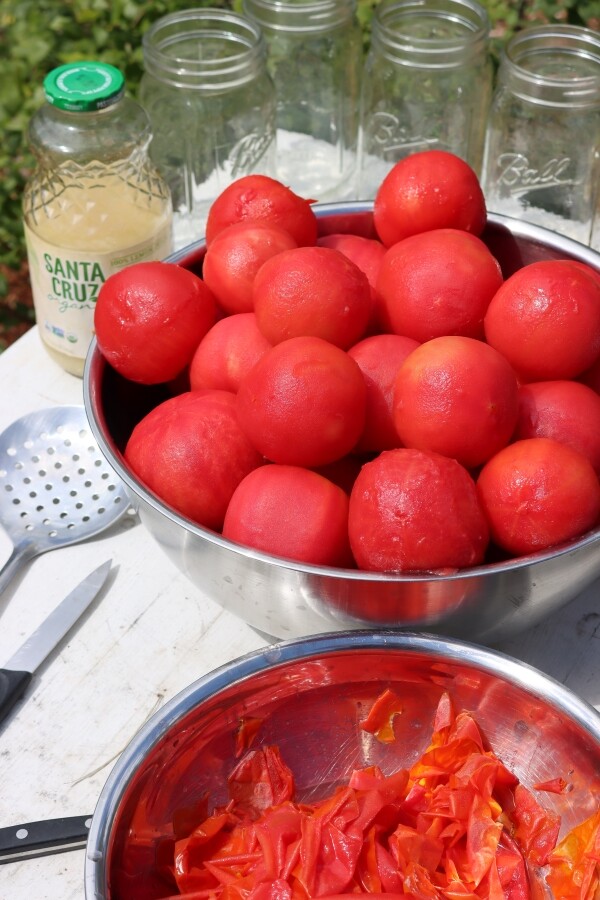
After the tomatoes are peeled, the next step is removing the core. This, again, is technically optional, but you’re going to need to remove it before cooking with home-canned tomatoes anyway so there’s no real reason to leave it in during the canning process.
Take a sharp paring knife and use it to pull out a small cone at the top of the tomato, working your way around the stem attachment site.
This should pull out the tough green core, but in some varieties, it goes a bit deeper into the tomato and you may need to clean it up further with your knife.
Be careful, of course, to not stab yourself here. Using a very sharp knife helps, as you’ll be using less pressure and less likely to slip.
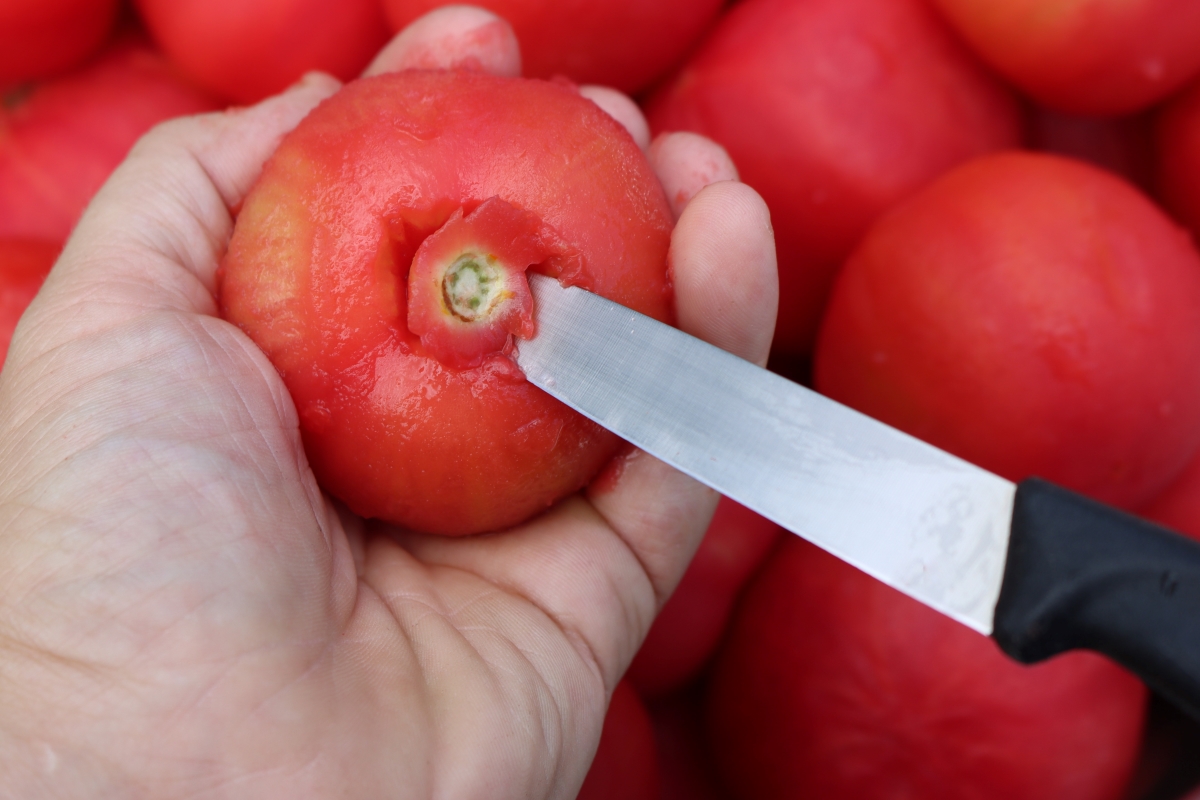
At this point, you can cut the tomatoes into halves or quarters if you wish, which will help them pack a bit tighter into the jar. I honestly just love the simplicity of canning whole tomatoes, so I don’t slice them further.
Acidification Before Canning Tomatoes
Regardless of the canning method chosen, you must add an acid source to the jar when canning tomatoes.
While tomatoes seem acidic, they’re actually right on the borderline for safe home canning. Their pH can vary considerably based on growing conditions (heat, sun, water, etc) and based on the variety.
Newer varieties have been intentionally bred for sweeter, less acidic tomatoes which means that while you may have gotten away with canning tomatoes without added acid 50 years ago, it’s no longer recommended.
The national center for food preservation provides these instructions for adding acid to canned tomatoes, using your choice of lemon juice, vinegar, or citric acid:
“To ensure safe acidity in whole, crushed, or juiced tomatoes, add two tablespoons of bottled lemon juice or 1/2 teaspoon of citric acid per quart of tomatoes. For pints, use one tablespoon bottled lemon juice or 1/4 teaspoon citric acid. Acid can be added directly to the jars before filling with product. Add sugar to offset acid taste, if desired. Four tablespoons of a 5 percent acidity vinegar per quart may be used instead of lemon juice or citric acid. However, vinegar may cause undesirable flavor changes.”
Citric acid will result in the most neutral flavor, while lemon juice will give them a slight hint of lemon, which is often nice depending on how you’ll use them.
Vinegar, while it seems neutral, actually reacts with the tomatoes a bit and makes them taste pickled, even when used in small quantities, so I don’t recommend it.
If using lemon juice, it must be bottled (rather than fresh) lemon juice because that comes at a standard acidity.
I’m using bottled lemon juice that I buy in big 32 ounce jugs from Santa Cruz Organics, simply because it’s one of the few bottled lemon juice options that doesn’t contain anything crazy. (Preservatives, additives, synthetic lemon oil, or really all the other crazy things that companies are putting in lemon juice for no reason these days…)
Whatever you use, simply add the appropriate amount to the bottom of the jar before packing the tomatoes. This ensures every jar gets the right amount, and that you don’t forget to add it later on in the process.
(Note: This is the same whether you’re water bath canning tomatoes or pressure canning. The pressure canning times are much shorter than they otherwise would be for tomatoes without added acid, and longer canning times at pressure would negatively affect the quality of the home-canned tomatoes.)
Headspace for Canning Tomatoes
As with adding acid, which is a constant for all methods of canning tomatoes, the headspace is also the same for every method.
Tomatoes are packed into jars, as whole or halves, leaving 1/2 inch headspace. If you look closely below, you’ll see that the liquid line is right at 1/2 inch in the picture below. This is the same whether you’re packing in water, tomato juice, or just simply packing without added fluid. When packing without added canning liquid, the level of the tomatoes must stay below the 1/2 inch headspace mark.
(If you look closely, you’ll also see the jars in the background don’t have the canning water added yet, but they already have lemon juice in the bottom of the jar. That’s added before tomatoes or any liquid even goes in the jar to make sure it’s not forgotten.)
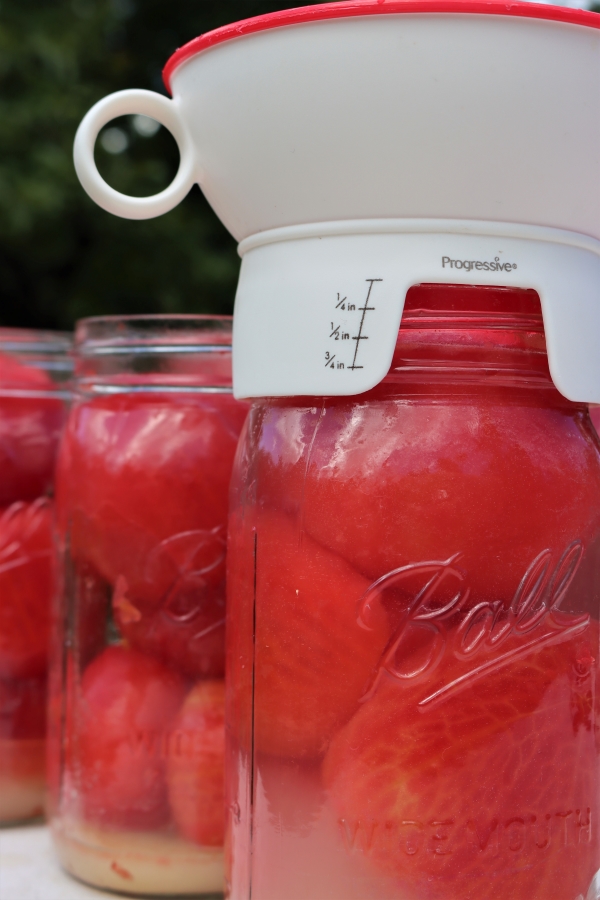
Process Times for Canning Tomatoes
At this point, believe it or not, you have a lot of choices when canning tomatoes.
You can choose a water bath canner or pressure canner, though I’m walking you through the water bath canning process. They can also be packed raw or hot, in water, tomato juice, or simply raw packed into jars with no added liquid (allowing them to juice off on their own).
Often when there are this many options, the canning instructions and process times are pretty similar for each option, but in this case, the canning times vary widely based on your choice.
Canning in tomato juice (rather than water) means you’ll be processing the jars for nearly double the time (85 minutes), since the tomato juice makes the contents of the jar much thicker and it takes more time for the heat to fully penetrate.
Raw packing the tomatoes without liquid similarly adds a lot of canning time, since you are effectively canning the tomatoes in their own juice as it seeps out of the fruits dry-packed into the jar.
I personally choose to raw pack in water, as it’s the simplest method that results in high-quality home-canned tomatoes with minimal effort (and a much shorter 45 minute canning time), but I’ll walk you through all the options.
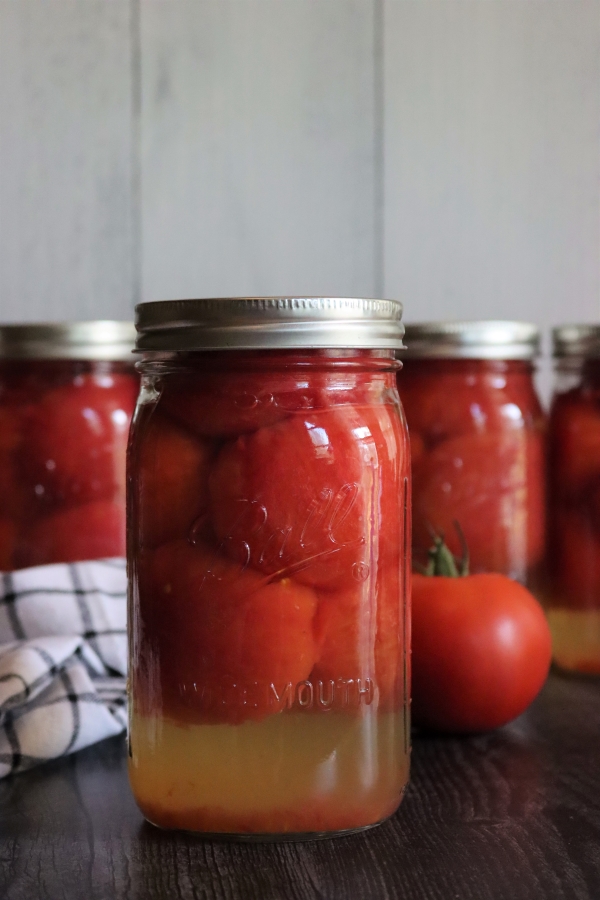
Canning Tomatoes in Water (Raw or Hot Pack)
This is my preferred method, and even there you have the option of raw or hot pack.
Raw Pack ~ When raw pack canning tomatoes in water, as I am here, the whole or half tomatoes are packed into jars (after the lemon juice is added), leaving 1/2 inch headspace. Boiling water is then poured over the tops of the tomatoes in the jar, filling each jar but still maintaining 1/2 inch headspace. Two-part lids are tightened into place and then the jars are processed.
This is a simple process, and it’s much easier to pack the tomatoes into jars when they’re at room temperature. The downside is that since they’re raw packed, they’ll float in the jars and won’t pack quite as tightly as hot packed tomatoes.
Hot Pack ~ In this case the tomatoes are put into a pot of boiling water (their canning liquid) and boiled for 5 minutes, which heats them through and causes them to shrink a bit as air bubbles inside the tomatoes escape during the boiling. They’ll pack much tighter into the jars since they’re pre-shrunk, and they’ll float less since they’ve already lost much of the air in their tissues.
The downside is it can be hard on the fingers to pack boiling hot tomatoes into jars. I can’t find a way to do it without burning myself, honestly, though I’m sure plenty of people manage it.
While I do strongly recommend hot packing other home-canned goods, as when you’re canning peaches or canning plums where the quality of raw packed fruit is horrible, I don’t think it makes much difference in the finished quality of home-canned tomatoes. I’m willing to let my tomatoes float a tiny bit to save burning my hands.
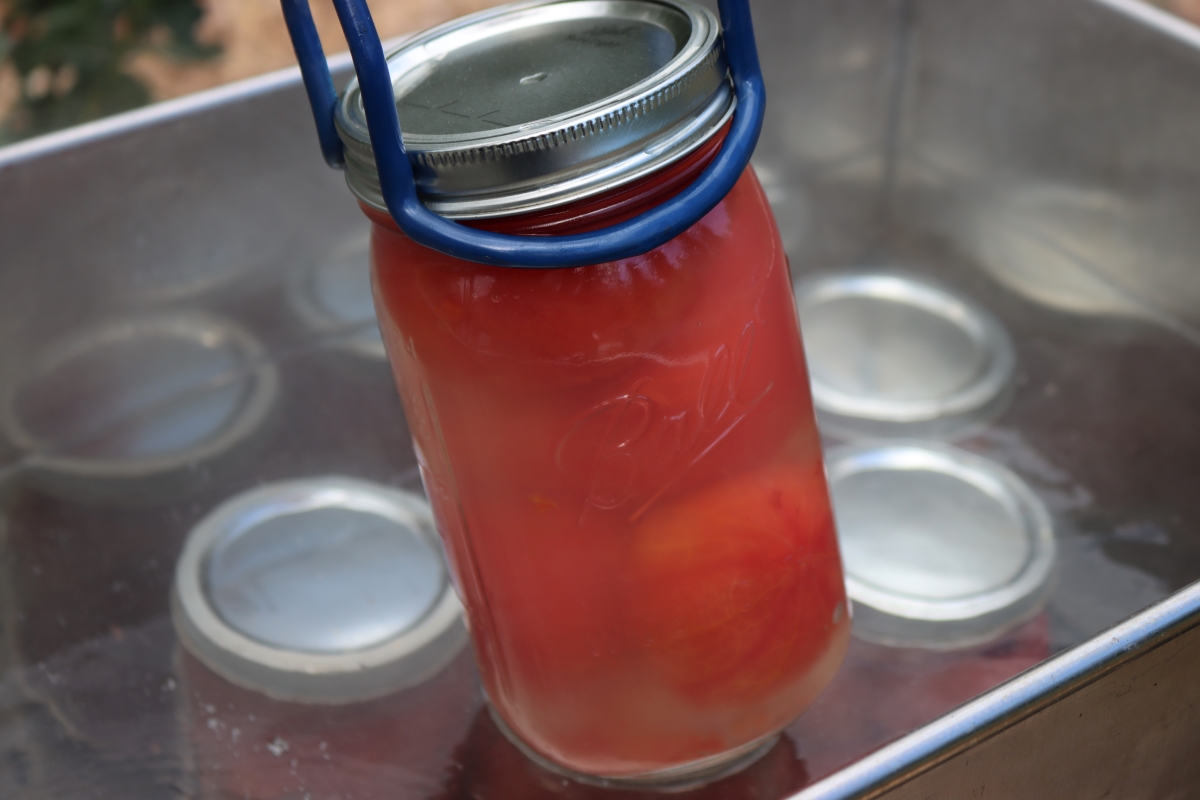
As I mentioned earlier, water packing tomatoes results in the shortest possible canning times.
When water-bath canning below 1,000 feet in elevation the jars are processed for 40 minutes for pints and 45 minutes for quarts in a water bath canner. For higher elevations, and pressure canning times, please refer to the table below.
(If you’re not familiar with pressure canning, please read this beginner’s guide to pressure canning before trying that method, but most people opt for water bath canning tomatoes since that is an available option.)
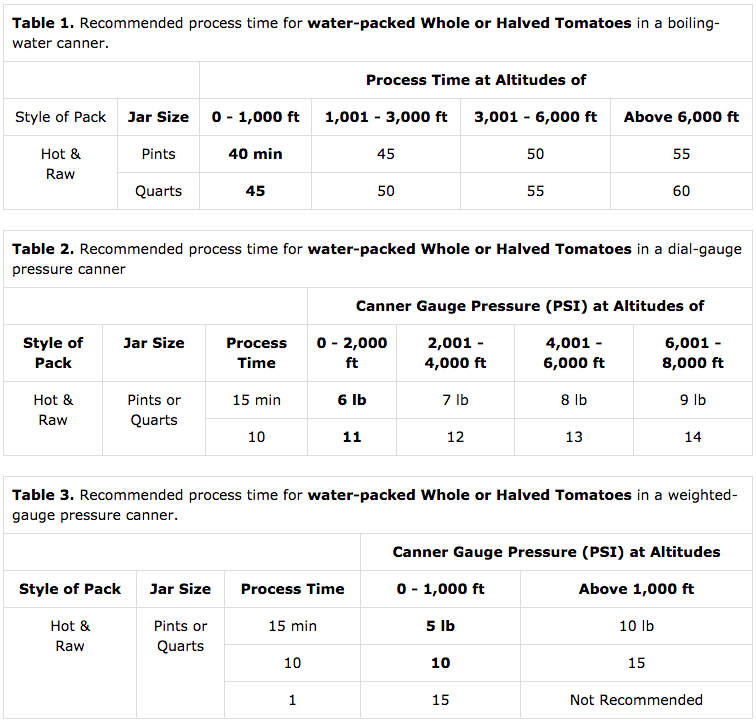
Canning Tomatoes in Tomato Juice (Raw or Hot Pack)
Tomato “juice” is actually pretty thick, and the added viscosity in the canning jar means a much longer processing time (both in a water bath canner and pressure canner).
I’m not talking about using a commercial tomato juice here, like some pre-canned V8 drink, I’m talking about making tomato juice out of a portion of your tomatoes and using that as your canning fluid for the remainder of the whole canned tomatoes.
The tomato juice you’d use for canning is almost tomato sauce, in fact, the process to make it is almost exactly the same. The only difference is tomato juice is cooked just barely long enough to break up the tomatoes, while the sauce is cooked until the volume is reduced by half. Cook it still further and you’ll have tomato paste.
To make tomato juice that’s approved for canning, follow these instructions from the National Center for Food Preservation:
“Wash, remove stems, and trim off bruised or discolored portions. To prevent juice from separating, quickly cut about 1 pound of fruit into quarters, and put directly into the saucepan. Heat immediately to boiling while crushing. Continue to slowly add and crush freshly cut tomato quarters to the boiling mixture. Make sure the mixture boils constantly and vigorously while you add the remaining tomatoes. Simmer 5 minutes after you add all pieces. If you are not concerned about juice separation, simply slice or quarter tomatoes into a large saucepan. Crush, heat, and simmer for 5 minutes before juicing. Press both types of heated juice through a sieve or food mill to remove skins and seeds.”
So it’s basically a thin tomato puree, with skins and seeds removed with a food mill or chinois sieve, that hasn’t been cooked down into tomato sauce.
After you’ve made the tomato juice, canning whole tomatoes in tomato juice follows the same process as canning in water, just with longer process times. Follow the instructions above to prepare the tomatoes, add lemon juice to each jar, and pack the whole tomatoes leaving 1/2 inch headspace, using either the raw pack or hot pack method (substituting tomato juice for water as the canning liquid).
Once you’ve packed the jars, use these processing times, adjusting to elevation and the type of canner you’re using:
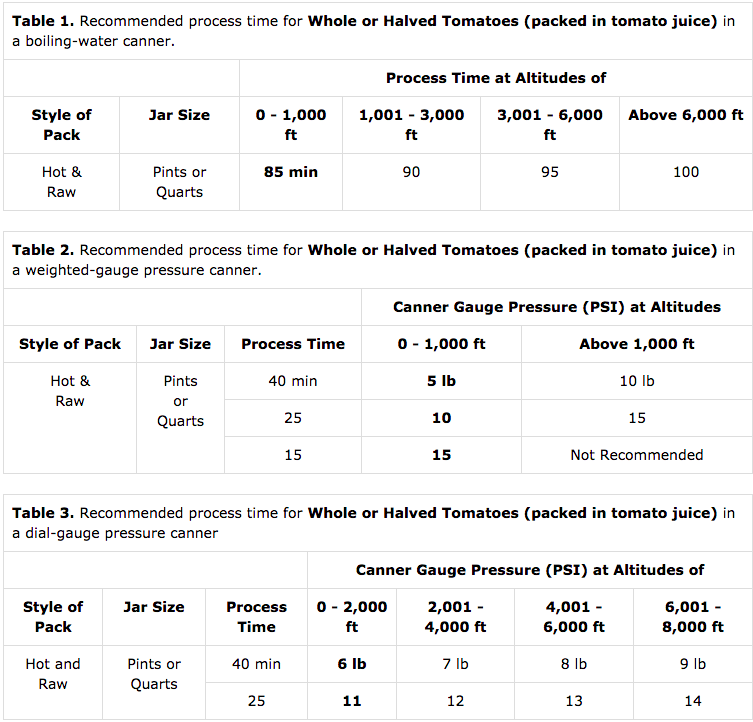
Canning Tomatoes Raw Pack without Added Liquid
The last option is simply canning tomatoes is to skip the canning liquid altogether, and just pack the peeled tomatoes raw into canning jars. As they process, they’ll release their own liquids to fill the jar.
Since you’re not adding liquid, the jars themselves will be partially empty since the tomatoes will cook down in the process. That’s totally normal, and it’s not uncommon to have 2+ inches of headspace at the top of the jar once the canned tomatoes come out of the water bath canner (even though they started with 1/2 inch).
Though the jars won’t be full, in theory, they should release enough fluid to cover the tomatoes in the jar, thus preventing discoloration during storage. (If they don’t and tomatoes are above the waterline, it’s just cosmetic, and they’re still safe but likely to discolor during storage.)
This process allows you to effectively can tomatoes in tomato juice, but without going through the trouble (and mess) of making tomato juice. This shortcut costs you a bit in quality though, as the tomatoes will fall apart more and the jars will be partially empty.
To can tomatoes without added liquid, simply pack peeled and cored tomatoes in pint or quart jars (remember the required lemon juice, citric acid, or vinegar). Use your hand to press them down a bit in the jar, causing them to pack tighter and release some of their juices. Pack the jars as full as you can, leaving 1/2 inch headspace.
Processes no liquid added tomatoes in a water bath canner for 85 minutes for pints and 90 minutes for quarts if you’re below 1,000 feet in elevation, or refer to the table below for higher elevations and pressure canning instructions:
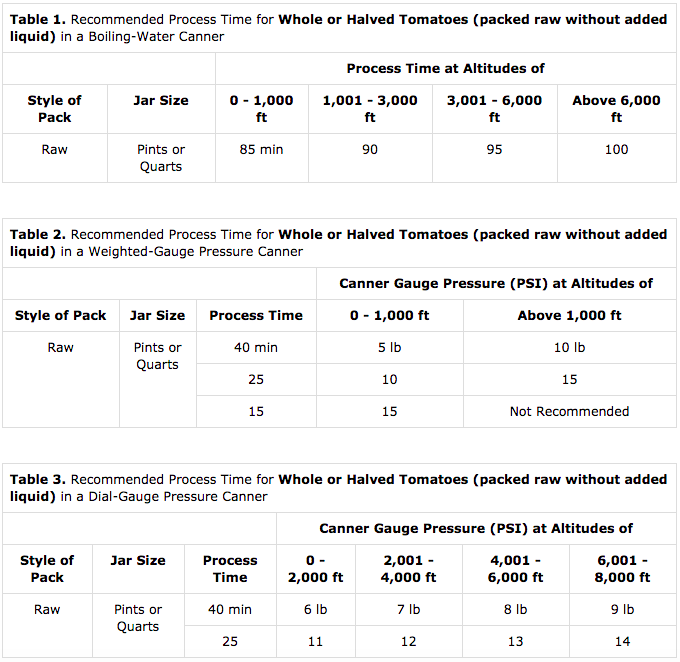
Tomato Canning Recipes
Need a few more tomato canning recipes?

Canning Tomatoes (Whole or Half)
Ingredients
- Tomatoes, see notes
- water
- lemon juice, NOT optional
- salt, optional
Instructions
- Prepare a water bath canner and canning jars/lids. I’m describing the raw pack method here, which requires a canner pre-heated to 140 degrees F. If opting for the hot pack method, preheat the canner to just simmering (180 degrees F).
- Bring a separate pot of water to a boil on the stove. Dip each tomato into the water for 30 to 90 seconds, until the skin cracks. Remove from the boiling water with a slotted spoon and place in a bowl of very cold water to cool.
- While the tomatoes cool, bring a kettle of freshwater to a boil to use as a canning liquid.
- Once cooled, remove the tomato skins gently with your fingers. If properly blanched, the tomato skins should slide off easily.
- Use a paring knife to remove the tomato cores.
- Add lemon juice to the bottom of canning jars before you pack the tomatoes, using 1 tablespoon per pint or 2 tablespoons per quart. This step is NOT OPTIONAL and is required for canning tomatoes in both a water bath and pressure canner. (Citric acid and vinegar are alternatives, see notes for quantities.)
- Pack tomatoes, as whole fruits or halves, into the canning jars on top of the lemon juice, leaving 1/2 inch headspace. If adding salt, the recommended amount is 1 tsp per quart or 1/2 tsp per pint, but salt is optional.
- Pour boiling water over the top of the tomatoes, filling jars but still leaving 1/2 inch headspace. De-bubble jars to ensure there’s no air trapped between the tomatoes and add water if necessary to maintain headspace.
- Seal the jars with 2 part canning lids to finger tight.
- Use a canning jar lifter to load the jars into a water bath canner. Since this is the raw pack method, the canner should have water that’s around 140 degrees (hot enough to burn your hand, but nowhere near boiling).
- Turn the heat up to high and bring the canner and it’s contents up to a full rolling boil. Once boiling begin timing the canning process. Water packed tomatoes need to process for 40 minutes for pints and 45 minutes for quarts in a water bath canner below 1,000 feet in elevation. See notes for altitude adjustments.
- Once the canning time is complete, turn off the heat and allow the jars to sit in the canner for 5 more minutes to cool slightly (this helps lower the risk of siphoning or liquid loss as they’re removed from the canner).
- Remove the jars to cool on a towel on the counter for 24 hours. After 24 hours, check seals and store any unsealed jars in the refrigerator for immediate use. Properly canned and sealed jars of tomatoes should maintain quality on the pantry shelf for 12-18 months.
Notes
- Lemon Juice – 2 tablespoons per quart or 1 tablespoon per pint (or)
- Citric Acid – 1/2 tsp per quart or 1/4 tsp per pint (or)
- Vinegar (at 5% acidity) – 4 tablespoons per quart or 2 tablespoons per pint
- For 0 to 1,000 Feet Elevation- 40 minutes for pints and 45 minutes for quarts
- For 1,001 to 3,000 Feet Elevation – 45 minutes for pints and 50 minutes for quarts
- For 3,001 to 6,000 Feet Elevation – 50 minutes for pints and 55 minutes for quarts
- For Altitudes Above 6,001 Feet – 55 minutes for pints and 60 minutes for quarts
Summer Canning Recipes
Canning more than just tomatoes this season?
Water Bath Canning Recipes
Pressure canning isn’t for everyone, but there’s plenty you can safely can in a water bath canner (besides this easy recipe for canning tomatoes). Read on my friends…
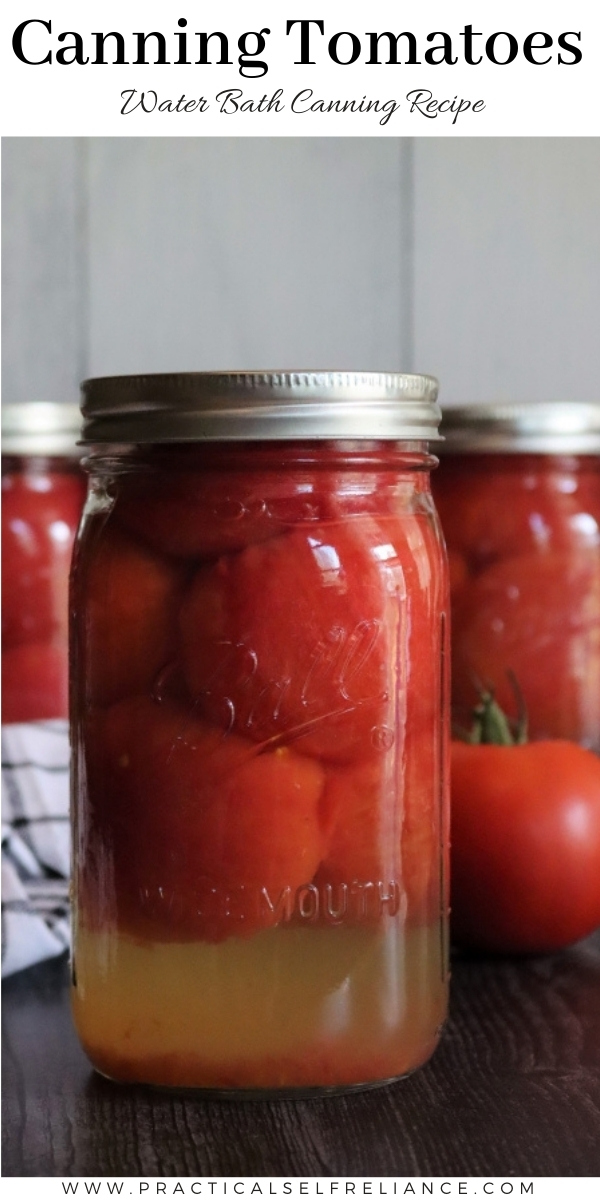
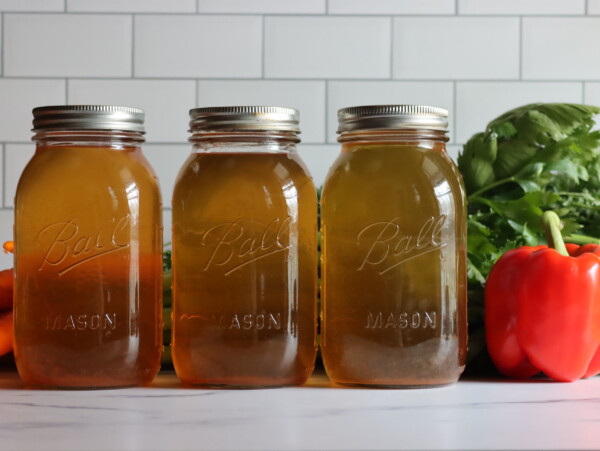
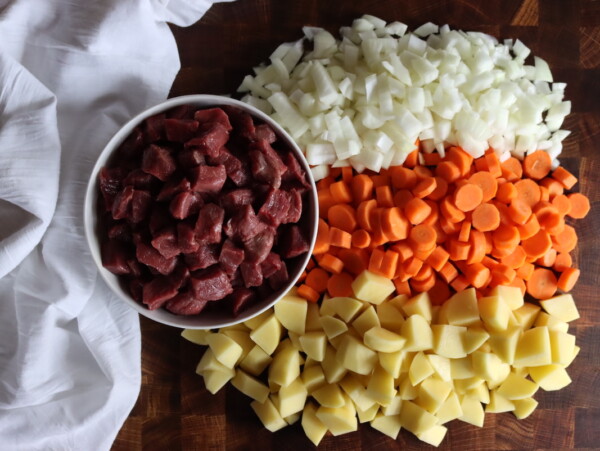












Do you have any recipes for canning in gallon jars? I’m interested in juice recipes.
The only two things that are approved for canning in half gallon jars are apple juice and grape juice. I do have recipes for those here:
https://creativecanning.com/canning-apple-cider/
https://creativecanning.com/canning-grape-juice/
l am really looking forward to trying some of your canning recipes, thank you so much, please email me any other canning recipes you might have please
I’m sorry but we can’t email you all of our canning recipes since there are so many. You can go to the website and subscribe to our email list and you will get regular email updates. https://practicalselfreliance.com/
I like to bake my whole tomatoes in order for the skins to fall off. The tomatoes are fully cooked by the time they come out of the oven. I want to do this right cuz tomatoes can be so dangerous. Can they go into hot jars then the boiling water to fill. How long do water bath them?
I am getting ready to make the paste tomorrow, I want to bake the tomatoes again, cuz I love the flavor that they have after the baking process. Will this get me into trouble?
Wanting to be safe.
I have not seen it done like that before. Most people that roast them will can them as a sauce or as crushed tomatoes rather than whole.
Hi Ashley!
I canned 10 pints of raw packed tomatoes in water last night. All the jars sealed. :-). I used your instructions to the letter.
Oleeta
That’s great! So good to hear.
If you boil all of the peach peels and pits, and then use them for canning syrup, you can get a superior raw pack peach. Admittedly, it is more work.
I also add two complete chopped heads of garlic and a double handful of red jalapenos to some or all of my canned tomatoes. I also core tomatoes and chop them in a food processor, skins and all, and have noticed no bitterness.
That’s a great idea on the pits/peels. I’ve used them to make peach jelly before, and they really do have a lot of flavor in there. I bet that would help retain flavor in the canned peaches really well.
Your charts are confusing. In SOME of the charts, there are numbers that are not explained and seem to have no relevance. For example Raw packing tomatoes whole or halved with no added liquid; pint or quart 40 minutes (what is the 25 under the 40?) 0 – 1000 ft 6lbs, what is the 11 under the 6lbs?) Please explain.
These charts actually come directly from the National Center for Home Food Preservation. If you are looking at the processing times column, those numbers all represent the processing time in minutes and the numbers in the 0-2,000 feet column represent the pounds of pressure on your pressure canner. For example in table 3 with an elevation of 0-2,000 feet you can either process the tomatoes for 40 minutes with 6 lbs of pressure or for 25 minutes with 11 lbs of pressure.
There used to be a cartoon, called Adam Ant. But I’m old. Is your name a pen name and a play on that?
Anyway, thanks for the info. The link was interesting and will lead me to much more “surfing.” I seem to remember a story from a couple years ago, that a sunken ship had been recovered (after what, 25-50 years?), and many canned foods were still fine, as long as still sealed. Yes, they suffered from taste and nutritional degradation, but were not spoiled or unsafe.
Ahh, had to look it up. It was Atom Ant, fitting for the age in which I grew up!
Great write-up as usual, Ashley, and thanks! So, I’m pretty well-versed on canning stuff; my tomatoes, I do pressure canning just because. But I wonder if you, or anybody else here, has an opinion of how long the canned tomatoes last until opened, using either method? I’ve opened up jars at like 5 years that smelled and tasted delicious.
Likewise, I’ve had canned tomatoes last for many years!
To the best of my knowledge, properly canned food doesn’t really “spoil” in the same sense we think of it for food in the refrigerator. (Assuming the seal is still solid. Ball canning lids now guarantee their seal for 18 months, but over time the gasket on the seal can break down, and then the food could actually spoil.)
There is an incredibly helpful write up on the shelf life of canned goods here: https://www.healthycanning.com/the-shelf-life-of-home-canned-goods/
That said, It does lose quality over time, and slowly break down. How much depends on what it is. After 12-18 months, some things are horrible. Lemon curd comes to mind, which only lasts 3-6 months canned in the best of cases. Canned peas also don’t last well in my experience.
Other things are good as they day they were canned at 18 months, and last much longer. Tomatoes and tomato products (sauce, etc) I’ve found last an absurdly long time, provided the seals stay good.
Enjoy!
SOOO much info,thanks Ashley..Agree with the comment about the size of tomatoes,here in Corfu Greece most of the tomatoes are huge about the size of a base ball and very tasty and juicy..
Defintely trying this recipe..
Really glad I found your site..😘
Wonderful, so glad it’s helpful to you!
Your Blog is extremely informative. I love it. The variety of adding acid to the process was something I didn’t consider.